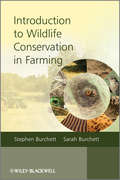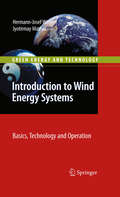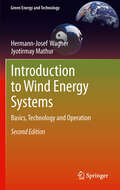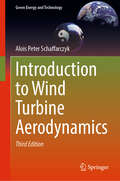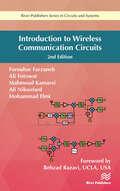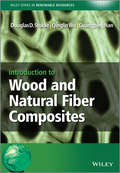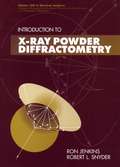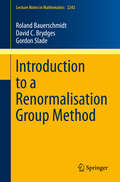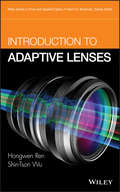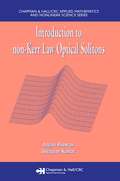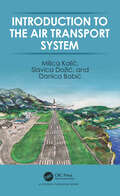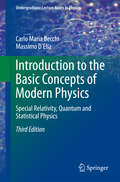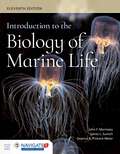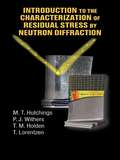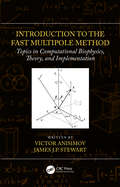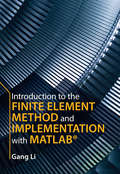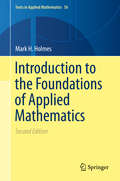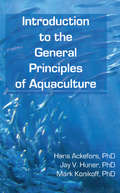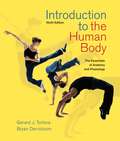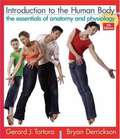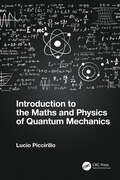- Table View
- List View
Introduction to Wildlife Conservation in Farming
by Stephen Burchett Sarah BurchettThis book provides an invaluable, comprehensive and practical introduction to conservation issues associated with current farming practice. Representing both industry and conservation as an integrated and holistic system, it explores conservation issues within every farming discipline; from arable and horticulture to grasslands, woodlands, aquatic and coastal farming and will include an assessment of the impact of global warming. The book includes relevant case studies and international, real-world examples, focusing on applied management and not just ecological facts, theories and principles.The carefully structured book begins by introducing the overall subject including some statistics on current farming activities, giving a brief outlook for the future of farming systems in relation to conservation. Each subsequent chapter will have its own introduction setting the commercial context and conservation value of an example farm, and will progress with a series of case studies that will include the following elements: site assessment; species list; soils management options; and a habitat management plan. A summary section will draw together the common themes of the chapter and develop a lead-in to subsequent chapters.It will provide students with an informed appreciation of current practice whilst raising questions about the development of conservation in farming in the future.
Introduction to Wind Energy Systems: Basics, Technology and Operation
by Hermann-Josef Wagner Jyotirmay MathurAuthors have tried to strike a balance between a short book chapter and a very detailed book for subject experts. There were three prime reasons behind doing so: first, the field is quite interdisciplinary and requires simplified presentation for a person from non-parent discipline. Second reason for this short-version of a full book is that both the authors have seen students and technically oriented people, searching for this type of book on wind energy. Third reason and motivation was considering engineers who are starting their career in wind industry. This book is targeted to present a good starting background to such professionals.
Introduction to Wind Energy Systems: Basics, Technology and Operation, 2nd Edition
by Hermann-Josef Wagner Jyotirmay MathurThe present book was written to address the needs of those readers interested in wind energy converters. The authors have tried to strike a balance between a short book chapter and a very detailed book for experts in the field. There were three prime reasons behind doing so: first, the field is highly interdisciplinary and requires a more accessible format for non-experts. The second reason for this more compact version is that both authors have encountered many students and technically oriented people who were searching for this type of book on wind energy. The third reason and motivation for writing this book was to provide some initial information to people who are embarking on a career in the wind industry. It is this group of people that the present book is targeted at.
Introduction to Wind Turbine Aerodynamics (Green Energy and Technology)
by Alois Peter SchaffarczykThis book is an introduction to wind turbine aerodynamics for professionals and students with a diverse range of backgrounds. It is a self-contained textbook that shows how to progress from the basics of fluid mechanics to modern wind turbine blade design. It presents the fundamentals of fluid dynamics and inflow conditions, as well as extensive information on theories describing the aerodynamics of wind turbines. After examining a number of related experiments, the book applies the lessons learned to blade design.The text of this 3rd edition has been thoroughly revised, and the book includes a new section on aerodynamic design and optimization.
Introduction to Wireless Communication Circuits (River Publishers Series In Circuits And Systems Is A Series Of Comprehensive Academic And Professional Books Which Focus On Theory And Applications Of Circuit And Systems. This Includes Analog And Digital Integrated Circuits, Memory Technologies, System-on-chip And Processor Design. The Series Also Includes Books On Electronic Design Automation And Design Methodology, As Well As Computer Aided Des)
by Forouhar Farzaneh Ali Fotowat Mahmoud Kamarei Ali Nikoofard Mohammad ElmiOver the past decade the tremendous development of Wireless Communications has changed human life incredibly. Considerable advancement has been made in the design and architecture of communications related RF and Microwave circuits. This book is focused on special circuits dedicated to the RF level of wireless Communications. From Oscillators to Modulation and Demodulation and from Mixers to RF and Power Amplifier Circuits, the topics are presented in a sequential manner. A wealth of analysis is provided in the text alongside various worked out examples. Related problem sets are given at the end of each chapter.
Introduction to Wood and Natural Fiber Composites
by Guangping Han Douglas D. Stokke Christian V. Stevens Qinglin WuOver the past two decades, there has been a shift in research and industrial practice, and products traditionally manufactured primarily from wood are increasingly combined with other nonwood materials of either natural or synthetic origin. Wood and other plant-based fiber is routinely combined with adhesives, polymers, and other "ingredients" to produce composite materials.Introduction to Wood and Natural Fiber Composites draws together widely scattered information concerning fundamental concepts and technical applications, essential to the manufacture of wood and natural fiber composites. The topics addressed include basic information on the chemical and physical composition of wood and other lignocellulosic materials, the behavior of these materials under thermocompression processes, fundamentals of adhesion, specific adhesive systems used to manufacture composite materials, and an overview of the industrial technologies used to manufacture major product categories. The book concludes with a chapter on the burgeoning field of natural fiber-plastic composites.Introduction to Wood and Natural Fiber Composites is a valuable resource for upper-level undergraduate students and graduate students studying forest products and wood science, as well as for practicing professionals working in operational areas of wood- and natural-fiber processing.For more information on the Wiley Series in Renewable Resources, visit www.wiley.com/go/rrsTopics covered include: Overview of lignocellulosic material, their chemical and physical compositionConsolidation behavior of wood and fiber in response to heat and pressureFundamentals of adhesionAdhesives used to bond wood and lignocellulosic compositesManufacturing technology of major product typesFiber/plastic composites
Introduction to X-Ray Powder Diffractometry
by Ron Jenkins Robert SnyderWhen bombarded with X-rays, solid materials produce distinct scattering patterns similar to fingerprints. X-ray powder diffraction is a technique used to fingerprint solid samples, which are then identified and cataloged for future use-much the way the FBI keeps fingerprints on file. The current database of some 70,000 material prints has been put to a broad range of uses, from the analysis of moon rocks to testing drugs for purity.Introduction to X-ray Powder Diffractometry fully updates the achievements in the field over the past fifteen years and provides a much-needed explanation of the state-of-the-art techniques involved in characterizing materials. It covers the latest instruments and methods, with an emphasis on the fundamentals of the diffractometer, its components, alignment, calibration, and automation.The first three chapters outline diffraction theory in clear language, accessible to both students and professionals in chemistry, physics, geology, and materials science. The book's middle chapters describe the instrumentation and procedures used in X-ray diffraction, including X-ray sources, X-ray detection, and production of monochromatic radiation. The chapter devoted to instrument design and calibration is followed by an examination of specimen preparation methods, data collection, and reduction. The final two chapters provide in-depth discussions of qualitative and quantitative analysis.While the material is presented in an orderly progression, beginning with basic concepts and moving on to more complex material, each chapter stands on its own and can be studied independently or used as a professional reference. More than 230 illustrations and tables demonstrate techniques and clarify complex material.Self-contained, timely, and user-friendly, Introduction to X-ray Powder Diffractometry is an enormously useful text and professional reference for analytical chemists, physicists, geologists and materials scientists, and upper-level undergraduate and graduate students in materials science and analytical chemistry.X-ray powder diffraction-a technique that has matured significantly in recent years-is used to identify solid samples and determine their composition by analyzing the so-called "fingerprints" they generate when X-rayed. This unique volume fulfills two major roles: it is the first textbook devoted solely to X-ray powder diffractometry, and the first up-to-date treatment of the subject in 20 years.This timely, authoritative volume features:* Clear, concise descriptions of both theory and practice-including fundamentals of diffraction theory and all aspects of the diffractometer* A treatment that reflects current trends toward automation, covering the newest instrumentation and automation techniques* Coverage of all the most common applications, with special emphasis on qualitative and quantitative analysis* An accessible presentation appropriate for both students and professionals* More than 230 tables and illustrationsIntroduction to X-ray Powder Diffractometry, a collaboration between two internationally known and respected experts in the field, provides invaluable guidance to anyone using X-ray powder diffractometers and diffractometry in materials science, ceramics, the pharmaceutical industry, and elsewhere.
Introduction to XAFS
by Grant BunkerX-ray absorption fine structure spectroscopy (XAFS) is a powerful and versatile technique for studying structures of materials in chemistry, physics, biology and other fields. This textbook is a comprehensive, practical guide to carrying out and interpreting XAFS experiments. Assuming only undergraduate-level physics and mathematics, the textbook is ideally suited for graduate students in physics and chemistry starting XAFS-based research. It contains concise executable example programs in Mathematica 7. Supplementary material available at www. cambridge. org/9780521767750 includes Mathematica code from the book, related Mathematica programs, and worked data analysis examples. The textbook addresses experiment, theory, and data analysis, but is not tied to specific data analysis programs or philosophies. This makes it accessible to a broad audience in the sciences, and a useful guide for researchers entering the subject.
Introduction to a Renormalisation Group Method (Lecture Notes in Mathematics #2242)
by Roland Bauerschmidt David C. Brydges Gordon SladeThis is a primer on a mathematically rigorous renormalisation group theory, presenting mathematical techniques fundamental to renormalisation group analysis such as Gaussian integration, perturbative renormalisation and the stable manifold theorem. It also provides an overview of fundamental models in statistical mechanics with critical behaviour, including the Ising and φ4 models and the self-avoiding walk. The book begins with critical behaviour and its basic discussion in statistical mechanics models, and subsequently explores perturbative and non-perturbative analysis in the renormalisation group. Lastly it discusses the relation of these topics to the self-avoiding walk and supersymmetry. Including exercises in each chapter to help readers deepen their understanding, it is a valuable resource for mathematicians and mathematical physicists wanting to learn renormalisation group theory.
Introduction to adaptive lenses
by Shin-Tson Wu Hongwen RenPresents readers with the basic science, technology, and applications for every type of adaptive lens An adaptive lens is a lens whose shape has been changed to a different focal length by an external stimulus such as pressure, electric field, magnetic field, or temperature. Introduction to Adaptive Lenses is the first book ever to address all of the fundamental operation principles, device characteristics, and potential applications of various types of adaptive lenses. This comprehensive book covers basic material properties, device structures and performance, image processing and zooming, optical communications, and biomedical imaging. Readers will find homework problems and solutions included at the end of each chapter--and based on the described device structures, they will have the knowledge to fabricate adaptive lenses for practical applications or develop new adaptive devices or concepts for advanced investigation. Introduction to Adaptive Lenses includes chapters on: Optical lenses Elastomeric membrane lenses Electro-wetting lenses Dielectrophoretic lenses Mechanical-wetting lenses Liquid crystal lenses This is an important reference for optical engineers, research scientists, graduate students, and undergraduate seniors.
Introduction to mineral sciences
by Andrew PutnisThe subject of mineralogy is moving away from the traditional systematic treatment of mineral groups toward the study of the behaviour of minerals in relation to geological processes. A knowledge of how minerals respond to a changing geological environment is fundamental to our understanding of many dynamic earth processes. By adopting a materials science approach, An Introduction to Mineral Sciences explains the principles underlying the modern study of minerals, discussing the behaviour of crystalline materials with changes in temperature, pressure and chemical environment. The concepts required to understand mineral behaviour are often complex, but are presented here in simple, non-mathematical terms for undergraduate mineralogy students. After introductory chapters describing the principles of diffraction, imaging and the spectroscopic methods used to study minerals, the structure and behaviour of the main groups of rock-forming minerals are covered, and the role of defects in the deformation and transformation of a mineral are explained. The energy changes and the rate of transformation processes are introduced using a descriptive approach rather than attempting a complete and rigorous treatment of the thermodynamics and kinetics. Examples and case histories from a range of mineral groups are set in an earth science context, such that the emphasis of this book is to allow the student to develop an intuitive understanding of the structural principles controlling the behaviour of minerals.
Introduction to non-Kerr Law Optical Solitons
by Anjan Biswas Swapan KonarDespite remarkable developments in the field, a detailed treatment of non-Kerr law media has not been published. Introduction to non-Kerr Law Optical Solitons is the first book devoted exclusively to optical soliton propagation in media that possesses non-Kerr law nonlinearities.After an introduction to the basic features of fiber-optic com
Introduction to the AdS/CFT Correspondence
by Horaţiu NăstaseProviding a pedagogical introduction to the rapidly developing field of AdS/CFT correspondence, this is one of the first texts to provide an accessible introduction to all the necessary concepts needed to engage with the methods, tools and applications of AdS/CFT. Without assuming anything beyond an introductory course in quantum field theory, it begins by guiding the reader through the basic concepts of field theory and gauge theory, general relativity, supersymmetry, supergravity, string theory and conformal field theory, before moving on to give a clear and rigorous account of AdS/CFT correspondence. The final section discusses the more specialised applications, including QCD, quark-gluon plasma and condensed matter. This book is self-contained and learner-focused, featuring numerous exercises and examples. It is essential reading for both students and researchers across the fields of particle, nuclear and condensed matter physics.
Introduction to the Air Transport System
by Milica Kalić Slavica Dožić Danica BabićThe book provides deep insights into the operations and business of the air transport system, i.e., airlines, airports, and ATC/ATM (Air Traffic Control/Management). It reviews activities of the air transport operators, functions and processes, as well as the needs and requirements of users and customers in a simple and easy to understand way. A brief description of aviation history, the air transport system development and processes are followed by the elaboration of the aircraft’s elements, masses, payload-range diagrams, and balance. The fundamentals of airports and the ATC/ATM service providers and their contribution to the air transport system are also provided. Moreover, the most important elements in the airport and ATC/ATM system are examined, and the rules, regulations and simplified approaches to how these systems operate are described. The airlines play an important role in the air transport system as users of the airports’ and ATC/ATM service providers. Different business models are presented as well as the fundamentals of airline planning, operations and management (including passenger demand, market segmentation, scheduling, tariffs, alliances, and frequent flyer programs). Besides passenger transport, the book contains an overview and comprehensive guide of the air cargo transport by addressing the key issues such as: the current trends, market characteristics, unit load devices, cargo handling, air cargo documents, and transport of different kind of goods (perishable, live human organs, live animals, dangerous, heavy, etc.).
Introduction to the Basic Concepts of Modern Physics
by Carlo Maria Becchi Massimo D'EliaThis is the third edition of a well-received textbook on modern physics theory. This book provides an elementary but rigorous and self-contained presentation of the simplest theoretical framework that will meet the needs of undergraduate students. In addition, a number of examples of relevant applications and an appropriate list of solved problems are provided. Apart from a substantial extension of the proposed problems, the new edition provides more detailed discussion on Lorentz transformations and their group properties, a deeper treatment of quantum mechanics in a central potential, and a closer comparison of statistical mechanics in classical and in quantum physics. The first part of the book is devoted to special relativity, with a particular focus on space-time relativity and relativistic kinematics. The second part deals with Schrödinger's formulation of quantum mechanics. The presentation concerns mainly one-dimensional problems, but some three-dimensional examples are discussed in detail. The third part addresses the application of Gibbs' statistical methods to quantum systems and in particular to Bose and Fermi gases.
Introduction to the Biology of Marine Life
by John Morrissey James L. Sumich Deanna R. Pinkard-MeierIntroduction to the Biology of Marine Life is an introductory higher education textbook for students with no prior knowledge of marine biology. The book uses selected groups of marine organisms to provide a basic understanding of biological principles and processes that are fundamental to sea life.
Introduction to the Characterization of Residual Stress by Neutron Diffraction
by M.T. Hutchings P.J. Withers T.M. Holden Torben LorentzenOver the past 25 years the field of neutron diffraction for residual stress characterization has grown tremendously, and has matured from the stage of trial demonstrations to provide a practical tool with widespread applications in materials science and engineering. While the literature on the subject has grown commensurately, it has also remained
Introduction to the Fast Multipole Method: Topics in Computational Biophysics, Theory, and Implementation
by Victor Anisimov James J.P. StewartIntroduction to the Fast Multipole Method introduces the reader to the theory and computer implementation of the Fast Multipole Method. It covers the topics of Laplace&’s equation, spherical harmonics, angular momentum, the Wigner matrix, the addition theorem for solid harmonics, and lattice sums for periodic boundary conditions, along with providing a complete, self-contained explanation of the math of the method, so that anyone having an undergraduate grasp of calculus should be able to follow the material presented. The authors derive the Fast Multipole Method from first principles and systematically construct the theory connecting all the parts. Key Features Introduces each topic from first principles Derives every equation presented, and explains each step in its derivation Builds the necessary theory in order to understand, develop, and use the method Describes the conversion from theory to computer implementation Guides through code optimization and parallelization
Introduction to the Finite Element Method and Implementation with MATLAB®
by Gang LiConnecting theory with numerical techniques using MATLAB®, this practical textbook equips students with the tools required to solve finite element problems. This hands-on guide covers a wide range of engineering problems through nine well-structured chapters including solid mechanics, heat transfer and fluid dynamics; equilibrium, steady state and transient; and 1-D, 2-D and 3-D problems. Engineering problems are discussed using case study examples, which are solved using a systematic approach, both by examining the steps manually and by implementing a complete MATLAB®code. This topical coverage is supplemented by discourse on meshing with a detailed explanation and implementation of 2-D meshing algorithms. Introducing theory and numerical techniques alongside comprehensive examples this text increases engagement and provides students with the confidence needed to implement their own computer codes to solve given problems.
Introduction to the Foundations of Applied Mathematics (Texts in Applied Mathematics #56)
by Mark H. HolmesThe objective of this textbook is the construction, analysis, and interpretation of mathematical models to help us understand the world we live in. Rather than follow a case study approach it develops the mathematical and physical ideas that are fundamental in understanding contemporary problems in science and engineering. Science evolves, and this means that the problems of current interest continually change. What does not change as quickly is the approach used to derive the relevant mathematical models, and the methods used to analyze the models. Consequently, this book is written in such a way as to establish the mathematical ideas underlying model development independently of a specific application. This does not mean applications are not considered, they are, and connections with experiment are a staple of this book. The book, as well as the individual chapters, is written in such a way that the material becomes more sophisticated as you progress. This provides some flexibility in how the book is used, allowing consideration for the breadth and depth of the material covered. Moreover, there are a wide spectrum of exercises and detailed illustrations that significantly enrich the material. Students and researchers interested in mathematical modelling in mathematics, physics, engineering and the applied sciences will find this text useful.The material, and topics, have been updated to include recent developments in mathematical modeling. The exercises have also been expanded to include these changes, as well as enhance those from the first edition.Review of first edition:"The goal of this book is to introduce the mathematical tools needed for analyzing and deriving mathematical models. … Holmes is able to integrate the theory with application in a very nice way providing an excellent book on applied mathematics. … One of the best features of the book is the abundant number of exercises found at the end of each chapter. … I think this is a great book, and I recommend it for scholarly purposes by students, teachers, and researchers." Joe Latulippe, The Mathematical Association of America, December, 2009
Introduction to the General Principles of Aquaculture
by Mark KonikoffIntroduction to the General Principles of Aquaculture provides novice aquaculturists with an overview of the aquaculture industry so you may proceed successfully in academic studies or commercial ventures. The authors furnish you with insight into the history and development of aquaculture and cover the subjects of natural production versus aquaculture, the aquatic environment, energy requirements of and relationships in aquaculture systems, important components of aquaculture systems, selection of aquaculture species, major cultured species and their distribution, global aquaculture production, a comparison of agriculture and aquaculture, and those factors promoting and constraining aquaculture. The book is liberally illustrated so that students and laymen are able to visualize systems and species. Furthermore, tables and figures are used throughout to emphasize important points, facts, and methods. As an introductory text, it emphasizes several aspects of aquaculture that must be understood by those new to the industry. These aspects include water quality, species of importance around the world, and current and projected aquaculture production on a global basis. The important components of any aquaculture system are also covered in some detail--biological factors, technical-biological factors, technical-economic factors, production cost factors, socioeconomic factors, and species selection factors.Laypersons considering aquaculture as an investment and students considering aquaculture as a career, but who have no real background in agriculture and fisheries sciences,will find this book to be a key information source. Introduction to the General Principles of Aquaculture is written with the global market in mind and instructors will find it to be a useful introductory text at the undergraduate level. Persons in advisory capacities such as County Extension Agents, extension service specialists and bureaucrats in various arms of government who hav
Introduction to the Human Body (Ninth Edition)
by Gerard J. Tortora Bryan H. DerricksonThe 9th edition of Tortora's "Introduction to the Human Body 8e" provides basic content, focused design, and relevant connections about the essentials of anatomy and physiology. All chapters are focused on the essential structure and functions of the human body needed for a basic understanding of homeostasis. The concise narrative is paired with outstanding illustrations, many newly revised for this edition, that help keep readers fully engaged with the topic at hand. Dynamic animations of key physiological processes as well as interactive anatomy reviews are fully integrated when the content is introduced in WileyPLUS. The new edition also features fully updated Clinical Connections that provide relevance to help understand what happens when homeostasis is disrupted, and providing insights into the content and knowledge to come in their allied health curriculum. The popular feature - Focus on Wellness - is completely updated with new content and topics. A pedagogical design is reflected in both printed text and WileyPLUS and clear learning objectives along with checkpoint questions for practice and review bookend each focused section of content within a chapter.
Introduction to the Human Body: The Essentials of Anatomy and Physiology
by Bryan Derrickson Gerard J. TortoraNIMAC-sourced textbook
Introduction to the Interstellar Medium
by Jonathan P. WilliamsThe gas and dust between the stars emit across the electromagnetic spectrum and are found in a range of physical conditions from diffuse plasmas to cold, dense molecules. Through their study we see how quantum processes shape the structure of our Galaxy and fluid mechanics sets the stellar mass scale. The Interstellar Medium is a very broad subject with layers of complexity, a long history and a steady flow of new results. This comprehensive yet accessible textbook provides a self-contained one-semester course for advanced undergraduate or beginning graduate students. It is written in a style that students can follow by themselves and allows instructors to use class time to go deeper into the details or show applications to current research. It makes extensive use of publicly accessible data to illustrate specific points and to encourage students to learn by performing their own analyses.
Introduction to the Maths and Physics of Quantum Mechanics
by Lucio PiccirilloIntroduction to the Maths and Physics of Quantum Mechanics details the mathematics and physics that are needed to learn the principles of quantum mechanics. It provides an accessible treatment of how to use quantum mechanics and why it is so successful in explaining natural phenomena. This book clarifies various aspects of quantum physics such as ‘why quantum mechanics equations contain “I”, the imaginary number?’, ‘Is it possible to make a transition from classical mechanics to quantum physics without using postulates?’ and ‘What is the origin of the uncertainty principle?’. A significant proportion of discussion is dedicated to the issue of why the wave function must be complex to properly describe our “real” world. The book also addresses the different formulations of quantum mechanics. A relatively simple introductory treatment is given for the “standard” Heisenberg matrix formulation and Schrodinger wave-function formulation and Feynman path integrals and second quantization are then discussed. This book will appeal to first- and second-year university students in physics, mathematics, engineering and other sciences studying quantum mechanics who will find material and clarifications not easily found in other textbooks. It will also appeal to self-taught readers with a genuine interest in modern physics who are willing to examine the mathematics and physics in a simple but rigorous way. Key Features: • Written in an engaging and approachable manner, with fully explained mathematics and physics concepts. <p class="MsoListParagraphCxSpMiddle" style="text-in
